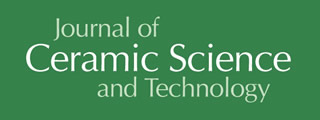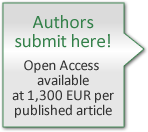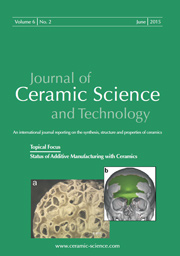Articles
All articles | Recent articles
Carbon-Bonded Alumina Refractories with Reduced Carbon Content due to the Addition of Semi-Conductive Silicon and/or Nanoparticles
N. Brachhold1, J. Fruhstorfer1, A. Mertke2, C.G. Aneziris1
1 TU Bergakademie Freiberg, Institute of Ceramic, Glass and Construction Materials, Agricolastr. 17, D-09599 Freiberg
2 Salzgitter Mannesmann Forschung GmbH, Eisenhüttenstrasse 99, D-38239 Salzgitter
received March 15, 2016, received in revised form May 1, 2016, accepted May 3, 2016
Vol. 7, No. 2, Pages 209-222 DOI: 10.4416/JCST2016-00024
Abstract
This study investigated the combined effect of nanoscaled additives (carbon nanotubes and nanoscaled alumina) and semi-conductive silicon on carbon-bonded alumina with a reduced primary carbon content of 20 wt%. It focused on the initial cold modulus of rupture and its evolution on exposure to thermal shock. The use of the single additive groups or their combination yielded an increased initial strength compared to the reference without additives. It was shown that the combination of the additives resulted in a material that exhibited no statistically significant decrease of the cold modulus of rupture in up to five thermal shock cycles. To understand these effects, physical properties (total porosity, open porosity, true density) were observed. The data showed that the microstructural reactions were complex. The combination of all additives caused a decrease in the open porosity. The available data of the true density analysis matched partly with the possible reactions. Especially the formation of SiC whiskers was considered to be important during the coking process and the thermal shocks. Furthermore, it was proposed that a deposition of carbon because of oxidation processes followed by reactions with the additives, especially the semi-conductive silicon, occurred, which might have a self-healing effect on the refractory matrix.
![]() Download Full Article (PDF)
Download Full Article (PDF)
Keywords
Nanoscaled additives, silicon, carbon-bonded alumina, semi-conductive material, reduced graphite
References
1 Salmang, H., Scholze, H., Telle, R.: Ceramics, in German, 7th Edition, Springer-Verlag, Berlin, Heidelberg, 2007.
2 Pierson, H.O: Handbook of carbon, graphite, diamond and fullerenes – properties, processing and applications, Noyes Publications, Park Ridge, New Jersey, 1993.
3 Krüger, A.: New carbon materials – an introduction, in German, 1st edition. B.G. Teubner Verlag, Wiesbaden, 2007.
4 Roungos, V., Aneziris, C.G.: Improved thermal shock performance of Al2O3-C refractories due to nanoscaled additives, Ceram. Int., 38, [2], 919 – 92, (2012).
5 Gardziella, A.: Chemistry and physics of duroplastic resins in plastics handbook vol. 10 duroplastics, in German, Editors: Becker, G.W., Braun, D., Woebcken, W., Carl HanserVerlag, Munich, Vienna, 1988.
6 Lewis, I.C.: Chemistry of carbonization, carbon, 20 [6], 519 – 529, (1982).
7 Guan, G., Kusakabe, K., Ozono, H., Taneda, M., Uehara, M., Maeda, H.: Preparation of carbon microparticle assemblies from phenolic resin using an inverse opal templating method, J.Mater. Sci., 42, [24], 10196 – 10202, (2007).
8 Bundes-Immissionsschutzgesetz BImSchG: Mit Durchführungsverordnungen, Emissionshandelsrecht, TA Luft und TA Lärm [Germany's Federal Ambient Pollution Control Act]. 10th edition, Deutscher Taschenbuch Verlag, 2010.
9 Kyoto Protocol, Third International Conference of the Parties Kyoto, Japan, December 11, 1997.
10 Buhr, A.: Trends in clean steel technology and refractory engineering, Plenary Speech, 14th Unified International Technical Conference on Refractories – UNITECR 2015, 15.-18.09.15, Vienna
11 Khezrabadi, M.N., Javadpour, J., Rezaie, H.R., Naghizadeh, R.: The effect of additives on the properties and microstructures of Al2O3-C refractories, J. Mater. Sci., 41, [10], 3027 – 3032, (2006).
12 Yamaguchi, A.: Self-repairing function in the carbon-containing refractory, Int. J. Appl. Ceram. Tec., 4, [6], 490 – 495, (2007).
13 Sunayama, H., Kawahara, M., Mitsuo, T., Sumitomo, K.: The effect of B4C addition on the oxidation resistance of Al2O3-C and Al2O3-SiC-C refractories, Proceedings of the Unified International Technical Conference on Refractories, 1997.
14 Zhang, S., Yamaguchi, A.: A comparison of Al, Si and Al4SiC4 added to Al2O3-C refractories, Proceedings of the Unified International Technical Conference on Refractories. New Orleans, USA, 1997.
15 Vieira Jr., W., Rand, B.: The nature of the bond in silicon-containing alumina-carbon refractory composites – Part I, Proceedings of the Unified International Technical Conference on Refractories. New Orleans, USA, 1997.
16 Zhang, S.: Next generation carbon-containing refractory composites, Adv. Sci. Tech, 45, 2246 – 2253, (2006).
17 Luhrsen, E., Ott, A.: Immersion nozzles for metal melts. U.S. Patent 5, 171, 495, 15, 1992.
18 Wang, T., Yamaguchi, A.: Antioxidation behavior and effect of Al8B4C7 added to carbon-containing refractories, J. Ceram. Soc. Jpn., 108, [9], 818 – 822, (2000).
19 Roungos, V., Aneziris, C.G., Berek, H.: Novel Al2O3-C refractories with less residual carbon due to nanoscaled additives for continuous steel casting applications, Adv. Eng. Mater., 14, [4], 255 – 264, (2012).
20 Yamaguchi, A., Zhang, S., Yu, J.: Effect of refractory oxides on the oxidation of graphite and amorphous carbon, J. Am. Ceram. Soc., 79, [9], 2509 – 2511, (1996).
21 Aneziris, C.G., Hubálková, J., Barabás, R.: Microstructure evaluation of MgO-C refractories with TiO2- and Al-additions, J. Eur. Ceram. Soc., 27, [1], 73 – 78, (2007).
22 Stein, V.: Contribution to the characteristic improvement of carbon bonded doloma refractories by addition of functional ceramic materials, Freiberger Forschungsheft, Reihe A, 905, (2011).
23 Stein, V., Aneziris, C.G., Guéguen, E., Hill, K.: A prospective way to reduce emissions in secondary steel making metallurgy by application of functionalized doloma carbon refractories, Int. J. Appl. Ceram. Tec., 9, [3], 615 – 624, (2012).
24 Stein, V., Aneziris, C.G.: Low-carbon carbon bonded alumina refractories for functional components in steel technology, J. Ceram. Sci. Tech., 5, [2],115 – 124, (2014).
25 Mertke, A., Aneziris, C.G.: The influence of nanoparticles and functional metallic additions on the thermal shock resistance of carbon bonded alumina refractories, Ceram. Int., 41, [1], 1541 – 1552, (2015).
26 Kunz, G.: Ladle refractories for clean steel production, RHI Bull., 2, 30 – 40, (2010).
27 Fruhstorfer, J., Schafföner, S., Werner, J., Wetzig, T., Schöttler, L., Aneziris, C.G., Thermal schock performance of refractories for application in steel ingot casting, J. Ceram. Sci. Tech., DOI: 10.4416/JCST2016 – 00010, (2016).
28 Montgomery, D.C., Runger, G.C., Hubele, N.F.: Engineering statistics, 4th Edition, Hoboken, NJ: Wiley, 2007.
29 Lautenschläger, K.-H.; Schröter, W., Wanninger, A.: Pocket book of chemistry, in German, 20., revised and extended addition, reprint, Frankfurt am Main, 2007
30 Tang, C.C., Fan, S.S., Dang, H.Y., Zhao, C., Zhang, P., Li, P., Gu, Q.: Growth of SiC nanorods prepared by carbon nanotubes-confined reaction, J. Cryst. Growth, 210, [4], 595 – 599, (2000).
31 Wu, Y.J., Wu, J.S., Qin, W., Xu, D., Yang, Z.X., Zhang, Y.F., Synthesis of β-SiC nanowhiskers by high temperature evaporation of solid reactants, Mater. Lett., 58, [17 – 18], 2295 – 2298, (2004).
32 Fan, H., Li, Y., Sang, S., Microstructures and mechanical properties of Al2O3-C refractories with silicon additive using different carbon sources, Mat. Sci. Eng. A, 528, [7 – 8] 3177 – 3185, (2011).
33 Tran, H.K., Sawko, P.M.: Thermal degradation study of silicon carbide threads developed for advanced flexible thermal protection systems, NASA Technical Memorandum 103952, 1992
34 Fruhstorfer, J., Möhmel, S., Thalheim, M., Schmidt, G., Aneziris, C.G.: Microstructure and strength of fused high alumina materials with 2.5 wt% zirconia and 2.5 wt% titania additions for refractory applications, Ceram. Int., 41, [9], 10644 – 10653, (2015).
35 Werner, J., Aneziris, C.G., Dudczig, S.: Young's modulus of elasticity of carbon-bonded alumina materials up to 1450°C, J. Am. Ceram. Soc., 96, [9], 2958 – 2965, (2013).
Copyright
Göller Verlag GmbH


